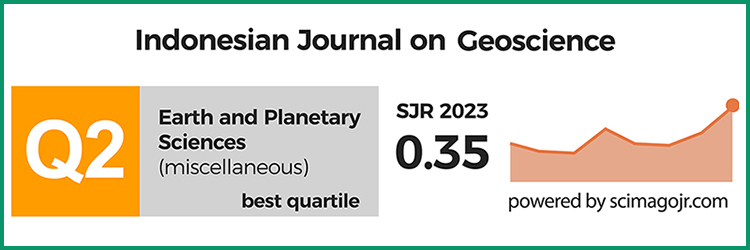Ichnofossil of Nanggulan Deltaic System: Case Study of Watupuru Cross Section in Kulon Progo, Central Java, Indonesia
DOI:
https://doi.org/10.17014/ijog.11.2.295-312Abstract
The Nanggulan Formation in Kulon Progo, Yogyakarta, Indonesia, is rich in ichnofossils as observed in a cross-section of the Watupuru River. This research aims to explore the relationship between ichnogenera, their behaviours and patterns during the deposition of the Nanggulan Formation in the Middle to Upper Eocene period. The study involved analyzing measured sections along the Watupuru River, paleocurrent measurements, and palynology. Seventeen ichnogenera were identified and linked to seven depositional facies within the Nanggulan Formation, i.e. Nummulites bank, prodelta, strand plain, delta front, delta plain, sandflat, and fluvial sand, categorized into autochthonous and allochthonous rock units. Allochthonous rocks, like tempestite and turbidite, were discovered within the autochthonous Nanggulan Formation with ichnogenera present in both types of rocks. Ichnofossils associated with the prodelta facies in autochthonous rocks included into Bergaueria, Siphonichnus, Phycodes, Trypanites, Treptichnus, Teredolites, Chondrites, and Thalassinoides, tend to indicate a muddy suspension environment. In contrast, the delta plain facies (FDP) indicating a calm oxidizing environment with ichnogenera contents like Teredolithes, Bergaueria, Scoyenia, Aulichnitus, Helminthopsis, Chondrites, Gastrochaelites, Ophiomorpha, and Siphonichnus were recognized. Factors influencing ichnofossil diversity include lighting, behaviour or adaptation to the environment, sedimentation rate, current control, and burrow infilling. The diversity of ichnofossils in allochthonous tempestite layers was influenced by post-catastrophic storm events. Barren ichnogenera at the base of tempestite layers indicated early storm surges, while the upper layers contained diverse ichnogenera such as Gastrochaelites, Psilonichnus, Bergaueria, and Planolites in the delta front facies (FDF). Tempestite layers in the sandflat facies (FSF) containing ichnogenera such as Thalassinoides, Bergaueria, Rhizocoralleum, Planolites, Cylindrichnus, and Siphonichnus, tend to show a favorable environment for organism post-storm.



















